 We are kicking off the month of August highlighting one of the most popular fruits grown in the United States, especially during the summer…
We are kicking off the month of August highlighting one of the most popular fruits grown in the United States, especially during the summer…
PEACHES!
And August just happens to be National Peach Month!
Who doesn’t love a fresh peach on a hot summer day?
First the sweet smell gets your tastes buds going, and then that delicious first bite, followed by the juice running down your arm…now that is summer flavor at its best! All this…plus, peaches are good for you!
Did you know that peaches originated in China and the country remains the largest producer? Residents consider them to be a symbol of longevity and good luck. In the U.S., peaches are grown commercially in 28 states, with the top peach producing states being California, South Carolina, Georgia and New Jersey. Different varieties of peaches ripen at different times of the year, meaning they are generally available May through October.
 Cling or Free?
Cling or Free?
Peaches are a member of the rose family and there are actually over 700 varieties of peaches. The two most common categories are clingstone and freestone.
Clingstone peaches: the flesh stubbornly “clings” to the stone or pit of the peach and can make it more difficult to separate. They are often used in processing and commercial production.
Freestone peaches: the flesh “freely” separates from the pit, making it ideal for eating fresh. They are often a little larger than clingstones.
Unfortunately, there is no way to tell just by looking at peaches whether they are clingstone or freestone. But you can let your calendar be your guide. Clingstone peaches are typically the first to ripen and the first to find their way to the farmers’ markets and stores. Freestone varieties tend to ripen later…for example, if you live in Michigan, you are probably familiar with the popular Red Haven variety. These are a very popular freestone variety, which generally ripen in early August. If you live in Georgia, you are likely to start seeing freestone peaches in mid-June.
Why should we include peaches in our routine?
 This juicy sweet fruit is a great source of fiber, antioxidants and vitamins A, B, and C…and a medium peach only contains about 60 calories! They are also loaded with other minerals such as potassium, which is very important for our health and helps regulate our heart rate and blood pressure.
This juicy sweet fruit is a great source of fiber, antioxidants and vitamins A, B, and C…and a medium peach only contains about 60 calories! They are also loaded with other minerals such as potassium, which is very important for our health and helps regulate our heart rate and blood pressure.
Peaches or Nectarines?
Nectarines are a variety of peach, just without the fuzz! They are almost identical genetically, but peaches contain a different gene which creates the fuzzy exterior. Nectarines tend to be firmer, smaller and more aromatic, and can be yellow and white, just like other peach varieties.
How do you pick them?
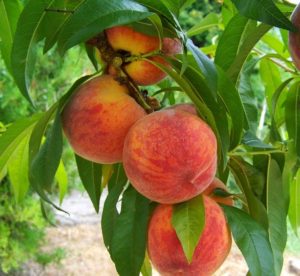 To tell if a peach is ripe, first, take a whiff! It should smell sweetly fragrant. It should also feel heavy and have a rich color.
To tell if a peach is ripe, first, take a whiff! It should smell sweetly fragrant. It should also feel heavy and have a rich color.
Some people like to squeeze the peaches to test for ripeness. Actually, the smell, feel and color are better indicators.
If you can’t resist the urge to squeeze, make sure it is a GENTLE squeeze! Peaches bruise easily and, once they are bruised, they begin to break down and deteriorate. Select aromatic, non-bruised, peaches with vibrant color.
Tips on storing peaches:
 The best way to ripen peaches is to place them on a counter or flat surface at room temperature. Place them on a kitchen towel (or paper towel) and place another towel over them. This will let the peach “breathe” and ripen within a couple of days. You can place them in a bowl but, ideally, they will ripen best if they are not touching each other.
The best way to ripen peaches is to place them on a counter or flat surface at room temperature. Place them on a kitchen towel (or paper towel) and place another towel over them. This will let the peach “breathe” and ripen within a couple of days. You can place them in a bowl but, ideally, they will ripen best if they are not touching each other.- Peaches will ripen best if they sit on their shoulders (stem side) vs their bottom.
- To speed up the ripening process, you can place peaches in a closed paper bag. The natural gases released from the peaches will help them ripen at a faster rate. To speed up the process even more, place a banana in the bag with the peaches and the natural gases from the banana will go to work.
- Once ripe and soft, storing them in the refrigerator will slow down (but not stop) the ripening process. If possible, be sure to eat your ripe peaches within 3-5 days (or freeze or can them before they go bad).
Turn brown?
Sliced peaches can turn brown after slicing, similar to apples, due to being exposed to oxygen. If you need to serve them sliced, rinse with cool water and toss with a little lemon juice to slow down the browning process.
Can’t use them fast enough? Freeze Them!
 Peaches, like many other in-season fruits and vegetables, can easily be frozen to preserve the flavors of summer! All fruits and veggies are welcome in the freezer, but remember, don’t freeze anything you wouldn’t eat right now! Freezing does not improve flavor…it preserves it!
Peaches, like many other in-season fruits and vegetables, can easily be frozen to preserve the flavors of summer! All fruits and veggies are welcome in the freezer, but remember, don’t freeze anything you wouldn’t eat right now! Freezing does not improve flavor…it preserves it!
One of the best tips when freezing peaches…freeze the pieces individually first! This tip works great for lots of produce, especially berries, peaches, and nectarines. Place the individual cut pieces (removing any pits) in a single layer on a baking sheet (lined with parchment paper if desired) and freeze until frozen and firm, then transfer to freezer bags or jars. This will save you time and headaches later on…we can tell you from experience, you don’t want to chisel a clump of peach slices apart later!
Ideas to include peaches in your meals!
Grilled, sautéed, baked, pickled, raw…there are a variety of ways to enjoy this sweet, juicy fruit of summer!
 Summer Peach Lettuce Wraps
Summer Peach Lettuce Wraps- Summer Bounty Buddha Bowl
- Peach Panzanella Salad
- Summer Basil & Peach Grilled Chicken
- Summer Peach and Tomato Salad
- Skillet Pork Chops with Peaches
- Grilled Summer Peach Sandwich
- Easy Peach Salsa (see how easy it is here!)
- Citrus Zucchini Salad
- Grilled Summer Pizza
- Quick Pickled Summer Peaches
- Grilled Chipotle Fish Tacos with Peach Salsa
- Peach and Tomato Gazpacho
- Peach and Pecan Pancakes
- Blackberry Peach Crisp (check out our video on how to enjoy peaches in the Everyday Fruit Crisp)
Summer in a glass!
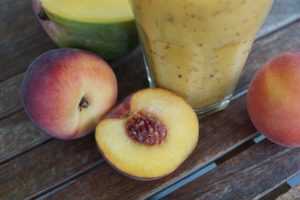 Peaches are also a great addition to summer drinks, including tea, water, lemonade, sangria and cocktails.
Peaches are also a great addition to summer drinks, including tea, water, lemonade, sangria and cocktails.
Try something new!
We hope this helps you enjoy this delicious summer fruit, and we encourage you to try peaches different ways…who knows, you may find a new favorite way to enjoy them!
 LEARN MORE ABOUT THE NAPKIN!
LEARN MORE ABOUT THE NAPKIN!
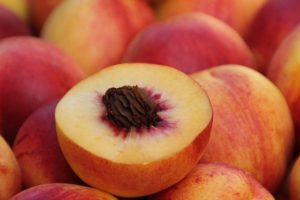
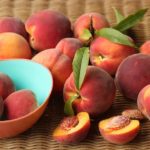
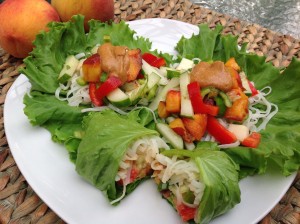
Leave A Comment